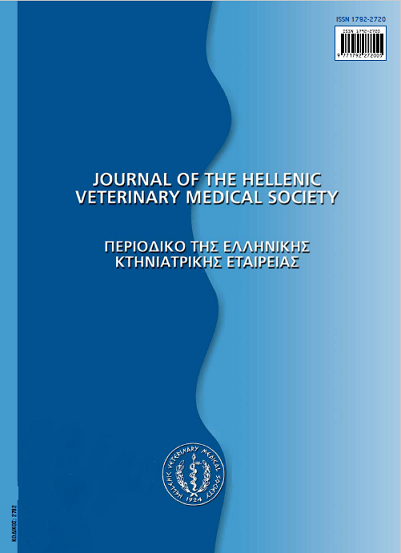Annual concentrations of thyroxin and progesterone in Karagouniko and Chios ewes
Abstract
The circannual secretion of progesterone and thyroxin of two indigenous sheep breeds (Chios and Karagouniko, each n=10) with different reproductive pattern was investigated. Blood samples were collected weekly and the serum hormone's concentration was assayed by RIA. Between breeds, no difference was detected in the mean annual thyroxin concentration. Similarly, no differences were detected within breeds in the mean thyroxin concentrations for the periods of increasing and decreasing daylight. Clear thyroxin peaks were detected in both breeds a month or so prior to the transition to anestrus period; these peaks were higher in the Karagouniko breed. Breeding season duration was clearly shorter in Karagouniko in comparison with that of Chios; in the later breed many animals had substantially short anestrus. These results give strong indications that thyroid activity has a catalytic role in the regulation of the reproductive period in ewes.
Article Details
- Zitationsvorschlag
-
KANTAS (Δ. ΚΑΝΤΑΣ) D., VALASI (Ε. ΒΑΛΑΣΗ) E., TSILIGIANNI (Θ. ΤΣΙΛΙΓΙΑΝΝΗ) T., NTOVOLOU (Ε. ΝΤΟΒΟΛΟΥ) E., & RIGAS (Γ. ΡΗΓΑΣ) G. (2018). Annual concentrations of thyroxin and progesterone in Karagouniko and Chios ewes. Journal of the Hellenic Veterinary Medical Society, 59(1), 46–51. https://doi.org/10.12681/jhvms.14946
- Ausgabe
- Bd. 59 Nr. 1 (2008)
- Rubrik
- Review Articles

Dieses Werk steht unter der Lizenz Creative Commons Namensnennung - Nicht-kommerziell 4.0 International.
Authors who publish with this journal agree to the following terms:
· Authors retain copyright and grant the journal right of first publication with the work simultaneously licensed under a Creative Commons Attribution Non-Commercial License that allows others to share the work with an acknowledgement of the work's authorship and initial publication in this journal.
· Authors are able to enter into separate, additional contractual arrangements for the non-exclusive distribution of the journal's published version of the work (e.g. post it to an institutional repository or publish it in a book), with an acknowledgement of its initial publication in this journal.
· Authors are permitted and encouraged to post their work online (preferably in institutional repositories or on their website) prior to and during the submission process, as it can lead to productive exchanges, as well as earlier and greater citation of published work.








